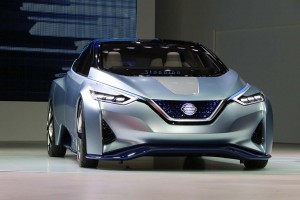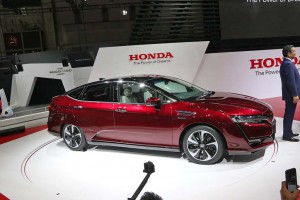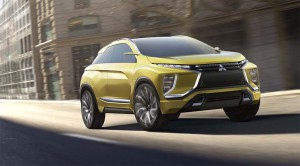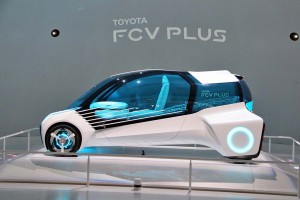
The design of the IDS Concept hints at the direction Nissan will take with the second-generation Leaf.
When the Olympics roll into Tokyo in 2020, visitors from around the world are likely to get a glimpse of the future as they race to the various sports venues now under construction around the sprawling, crowded city.
One choked by pollution, Tokyo plans to use the Olympics to showcase groundbreaking environmentally friendly – and safe – automobiles. But there’s no need to wait four years. The 2015 Tokyo Motor Show is already offering a glimpse of what’s coming.
Among the futuristic models introduced at the show this week, Nissan’s IDS – short for Intelligent Driving System – can be driven autonomously and, with its 60 kilowatt-hour battery pack, can clock about 200 miles between charges. That intelligent drive system, claims CEO Carlos Ghosn, is capable of learning the habits of its owner to modify the way it drives, even to recommend places to stop for a bite.
Nissan was the first major automaker to mass produce a fully electric vehicle, the Leaf. And it hopes to be first to market, by 2020, with an autonomous vehicle capable of operating both on highways and in more challenging urban conditions.
That would “compensate for human error which causes more than 90% of accidents,” said Ghosn, during the unveiling of the IDS.
(Click Here for a test drive of a fully autonomous Nissan Leaf prototype.)
Nissan may be angling to be first, but it is by no means alone. The sprawling Tokyo Big Sight convention center is chock full of zero-emission production and concept vehicles, as well as autonomous prototypes.
Little Mitsubishi joins its bigger rivals with the battery-powered eX, a prototype expected to foreshadow the next version of its Outland Sport SUV. Mitsubishi is already offering an electric minicar, the pint-sized i-MiEV, but the eX would deliver more than twice the range, better performance – and semi-autonomous capabilities.
Among other things, a driver can exit the vehicle, hit a button on the key fob and the Mitsubishi eX will go park itself, even begin to recharge wirelessly.
It’s hard to find any manufacturer not offering – or at least developing – a fully electric vehicle. But sales have so far been disappointing. And if they agree on nothing else, various Japanese automotive executives concurred during the show that limited range and long charging times, as well as high cost, are key reasons why demand has been limited.
That could change. Battery prices are plunging, even as they get lighter, smaller and more powerful. That 60 kWh battery from the Nissan IDS concept will be offered in the next-generation Leaf sedan, company insiders confirm.
(To see more about the battery-powered Mitsubishi eX concept, Click Here.)
But not everyone is sure that will be enough. Toyota is betting on a different approach to clean air. It began selling its new Mirai fuel-cell vehicle just before the Tokyo Motor Show, and contends the technology is the real future of zero-emissions driving. Fuel cells have the advantage of longer range – up to 300 miles in the Mirai – and refilling times similar to what customers are used to with gas-powered vehicles.
The challenge is a severe lack of hydrogen filling stations. But Toyota, Honda and Nissan have formed a consortium aimed at setting up a network of pumps around Tokyo and other parts of Japan in time for the Olympics. In the U.S., the State of California is funding a similar effort.

The 2016 Honda Clarity fuel cell vehicle will be available soon in Japan, but on a lease-only basis in the U.S. next spring.
Honda used the Tokyo Motor Show to reveal its new Clarity fuel-cell vehicles which will go on sale in Japan and the U.S. early next year.
Toyota, meanwhile, offered a more futuristic prototype, the FCV-Plus. The concept vehicle was designed around the unique layout of a fuel-cell system, rather than making that drivetrain fit into a conventional car body. Among other things, it uses four electric wheel motors. This allowed Toyota engineers to open up virtually the entire body to passengers and cargo, the compact FCV-Plus offering almost van-like room and a design right out of a sci-fi flick.
Automakers also are debating how far to go with autonomous technology. Toyota is betting that tomorrow’s smart cars will simply assist the driver in making better, safer decisions. Nissan wants to let a motorist choose between assisted and fully autonomous driving. Others are talking about an era when there won’t be a driver at all. Simply use a smartphone app and a driverless taxi – or Uber car – will show up at your door.
But in one form or another, the technology is about to jump from fiction to reality, said Fumihiko Ike, the chairman of Honda.
(Toyota pushes boundaries with FCV Plus. For more, Click Here.)
“Self-driving technology has a great opportunity,” said Ike, who oversaw this year’s show as the head of Japan Automobile Manufacturers Association, “to bring about zero accidents and zero traffic problems.”
And in a city as crowded as Tokyo, that’s a fantasy everyone is hoping will soon come true.


